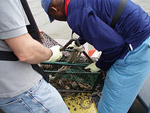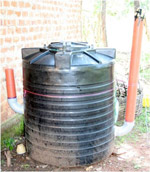Yale University scientists say that wastewater treatment plants may not be able to remove all quaternary amines discharged with household detergents and shampoos, allowing the formation of nitrosamines, a suspected cancer-causing contaminant.
Work included cleaning the interiors of all 58 onsite buildings, a process consisting of HEPA vacuuming, wet wiping, and the use of negative air machines.
In recent testing at the Army’s Aberdeen Proving Ground, INL researchers have been using ultraviolet-wavelength lasers to scrub surfaces clean of sulfur mustard gas and VX, a nerve agent.

American Wind Energy Association conference presenters say the industry needs a renewable electricity standard and more incentives from the government to prosper.
- By L.K. Williams, EPonline
Group's climate director says Congress needs to put a price on carbon pollution and develop an international clean tech program.
U.S. District Court judge orders company to serve three years of probation and implement an environmental compliance plan.
The institute will work to solve key scientific and technology challenges facing the wind power industry.

Data of unaffected waters is critical to measuring ecological impact of Deepwater Horizon BP oil spill; agency also determines fishery disaster for Louisiana, Mississippi, and Alabama.
Speaking at AIHce in Denver, Robert F. Kennedy Jr. said owners of small wind and solar farms should be able to transmit their energy to the national grid.
The International Electronics Recycling Conference singled out Sprint for its leadership in recycling wireless handsets.
BLT Enterprises' Fremont, Calif., operation adds new layer of sustainability with the help of Solar Power Inc.
Invasive vine's chemicals combine with nitrogen to produce ozone and lead to about a 50 percent increase in the number of days exceeding healthy ozone levels, research models show.

A University of Virginia doctoral candidate and an engineer use capacity factor analysis to determine the best way to implement a biogas cooking fuel system in Namawanga, Kenya.
Four years after the National Academy of Sciences completed its review of EPA's draft dioxin reassessment, the agency responds with answers and new information.
Water Enabled Technologies and Clemson University signed a memorandum of understanding in which the university will help develop products for a new water desalination process.
The National Renewable Energy Laboratory study calls for increased coordination over wider areas and more frequent scheduling.
Officials hope that an ARRA-funded green roof will help manage stormwater and they plan to monitor the solution using Web-based weather stations.
According to the agency, many facilities have already begun implementing recommendations to improve safety of their impoundments.
RGGI, the Accord, and WCI outline their vision of key design and implementation criteria necessary to establish a high-quality offset program.